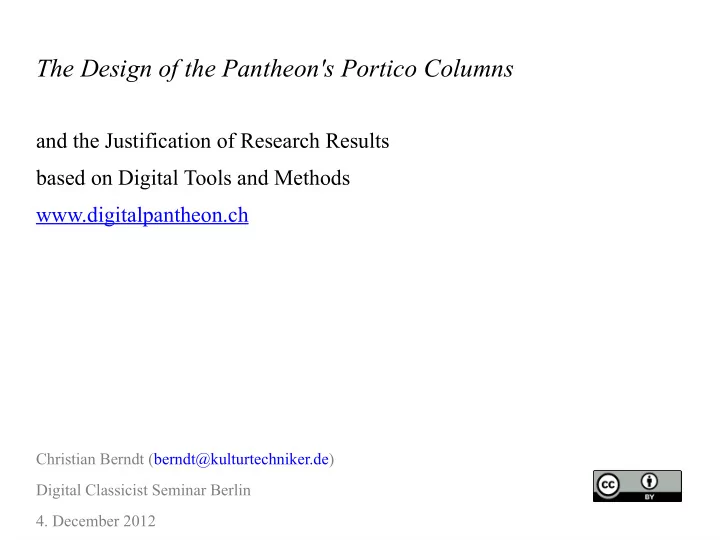

The Design of the Pantheon's Portico Columns and the Justification of Research Results based on Digital Tools and Methods www.digitalpantheon.ch Christian Berndt (berndt@kulturtechniker.de) Digital Classicist Seminar Berlin 4. December 2012
Outline � Project History � The Question of the Entasis Design � The Epistemic Relevance of Open Access and Open Data � Requirements Catalogue for Digital Research Tools and Methods � Lessons learned
Scanning Process, Terrace north of the Pantheon (BDPP0605)
Scanning Process at a Portico Column (BDPP0602)
Visualization of the Unified Point Cloud (BDPP0009)
Overview of „Greek Refinements“ (Coulton 1977, Fig. 44)
Coordinates and Slices of Column A1 (BDPP0716)
Geometry and Construction of the Portico Columns
Comparison of the Shaft Profiles (BDPP0748)
Vitruv, De Architectura Libri Decem, III.3.13 De adiectione, quae adicitur in mediis columnis, At the end of the book I shall record the quae apud Graecos [entasis] appellatur, in illustration and method for the addition made to extremo libro erit forma et ratio eius, the middles of columns, which is called entasis quemadmodum mollis et conveniens efficiatur, (bowing) by the Greeks and how to execute this subscripta. refinement in a subtle and pleasing way.
Entasis Construction at Didyma (Haselberger 1980, Beilage 1)
Geometrical Description of the Didyma Method
Interactive Construction Model (BDPP0752)
Distribution of the Construction Circle Centers
Two Types of Circle Segment Constructions
Two Types of Circle Segment Constructions
Measurement of the Portico Columns by Stevens, early 1920s
10 Requirements for Digital Tools and Methods 1) Explication of the Hypothesis 6) Documentation of Operational Interrelationships 2) Reasonable Modularization 7) Reliable Adressability 3) Explication of the Assumptions 8) Precise Dating and Versioning 4) Declaration of the Means of 9) Open Access Proof 10) Mid- and Longterm 5) Open and Complete Accessibility Communication
Recommend
More recommend